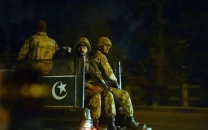Digital security: Online harassment silencing some journalists
Report says most journalists feel digitally insecure with women more at risk to harassment

Dad, who had edited the report, believes that online harassment is a gendered crime since a majority of the victims (67 per cent of callers) are women. PHOTO: EXPRESS/FILE
This was revealed in a survey report, "Digital (in)security of Journalists in Pakistan", released by the Digital Rights Foundation (DRF) this week.
The report explores the levels of digital threats that journalists face, their experiences of online insecurity, and recommends steps which they can take to protect themselves in the wild west of the online world.
Its survey found that 66 per cent of journalists felt they were digitally insecure through some form of digital attack either through a hack — as was the event of Hamid Mir’s twitter account, threatened by intimidating interactions on social media, blackmailed or harassed by trolls over a sustained period of time, sexually harassed, having your data stolen, being cyber-stalked, or even receiving malware or phishing emails.
Report reveals surge in online harassment cases
The report found that harassment was the most common threat which journalists faced online with 78 per cent of respondents of the survey experiencing some form of online threat or harassment.
As a consequence, 45.5 per cent of them thought that online insecurity caused them to self-censor themselves. Similarly, 33.3 per cent of respondents said they reduced their use of social media after facing online insecurity of different types. As many as 15.2 per cent had deactivated their social media accounts out of fear.
Moreover, 56 per cent felt that online insecurity was tied with their physical safety — giving rise to the fear among a majority of respondents that the virtual world could catch up to them in the real world too.
“For journalists, online harassment has more direct implications for freedom of expression because it can lead to self-censorship and reticence towards reporting on certain subjects,” DRF Executive Director Nighat Dad told The Express Tribune.
“In DRF’s experience, online harassment occurs on a continuum with offline violence and restrictions, often replicating non-virtual structures,” she said.
Dad, who had edited the report, believes that online harassment is a gendered crime since a majority of the victims (67 per cent of callers) are women. In the context of journalists, this means that women are more at risk online than men.
This was backed by how 72 per cent of female journalists reported having experienced digital insecurity as opposed to 61 per cent for men, noting that harassment was more tied to the gender.
To make matters worse, around a third of journalists surveyed did not know what to do when subjected to a digital crime or harassment. For those who knew that they had to contact law enforcement, 62 per cent said they did not know just how they would contact them.
This was exacerbated by how a majority of respondents said that their organization did not provide any training on digital security.
The DRF recommended that digital safety should be institutionalised with organisations taking a greater interest in training their employees. Develop better communication channels with social media companies, set up internal systems to report the attack, remove obstacles to the use of encryption technology.
Moreover, FIA should be provided with more resources to help journalists.



















COMMENTS
Comments are moderated and generally will be posted if they are on-topic and not abusive.
For more information, please see our Comments FAQ